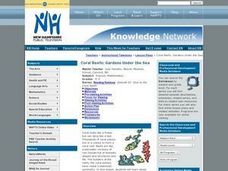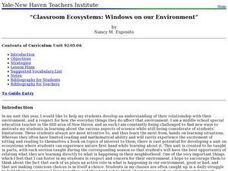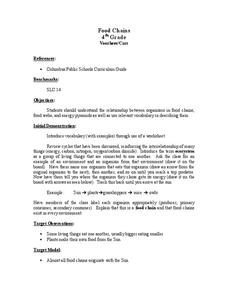Curated OER
Our Land: League Philanthropy Unit
Learners use the folk singer Woody Guthrie's song 'This Land is Your Land' to learn about the responsibility of every person to take care of each other and the land. In this land preservation lesson plan, students sing the song, learn...
Curated OER
Ecosystem
In this word search worksheet, students locate the words relating to ecosystem science within the butterfly shaped word search puzzle. Students locate 16 words.
Curated OER
What Makes Up an Ecosystem?
In this ecosystem introduction worksheet, students examine a picture of an ecosystem and respond to 4 short answer questions.
Curated OER
Biomes
In this biomes learning exercise, students review the characteristics of aquatic biomes and terrestrial biomes. This learning exercise has 12 fill in the blank, 6 multiple choice, and 4 short answer questions.
Curated OER
Who Lives in a Wetland?
In this science worksheet, students list the names of 14 animals that live in a wetland. The animals are pictured and numbered. Students identify the animals and color the picture.
Curated OER
Biology Matching Worksheet
In this food chain worksheet, learners find the correct definition to match the vocabulary word. The answers are found by clicking the button at the bottom of the page.
Curated OER
Soda Bottle Compost: Nutrient Cycling in Action
Young scholars explore and observe significant contributions to wildlife and measure soil nutrient capacity by performing simple tests to determine the amount of phosphorous. They assess the importance of making and recording detailed...
Curated OER
Coral Reefs: Gardens Under the Sea
Students discover the wonders of coral reefs while listening to a book about them. In a Reading Rainbow video activity, they simulate a dive, check equipment and explore a reef. Role-playing as marine biologists, students uncover...
Curated OER
Ecosystems II
Students engage in a lesson that is about the concepts related to the careful balance of an ecosystem. They identify the beneficial and harmful relationships that can exist with diverse populations in an ecosystem. The lesson includes...
Curated OER
Mini-Ecosystems
Third graders identify the living and non living things in a book read aloud and discuss the interactions represented in the book. Then, they research and include a list of food that each animal needs in an ecosystem. Finally, 3rd...
Curated OER
The Integration of Science and Math Through Ecosystems
Students use the disciplines of math and science to examine ecosystems. In groups, they calculate the amount of supplies they would need to live in the classroom for one day, a week and a year. Using this information, they apply it to...
Curated OER
Classroom Ecosystems: Windows on our Environment
Students in a special education classroom examine their relationship with the environment. As a class, they examine the concept of a web of life and create their own classroom ecosystem. In groups, they record their observations and...
Curated OER
Plants of the Past
Fourth graders explore ecosystems by examining plants of the past. They discuss ways in which we interact with plants in our daily lives. Students discuss the role plants play in providing food for animals and the significance they had...
Curated OER
Primary And Secondary Succession
Students cover the topics of primary and secondary succession with interest to its ties in the study of ecosystems. They study how the introduction of an insect can effect the ecological balance. Students make predictions and write them...
Curated OER
Food Webs
Learners investigate the concept of an ecosystem and how they are interconnected according to a hierarchy. Students are exposed to the "Lion King" as an example of a food chain and this is very relevant. They answer several key...
Curated OER
Fish Haunts
Students examine some of the different ecosystems that fish live in. While doing this they identify the species of fish and the ecological conditions needed for survival. Students use research resources to make fish cards that have...
Curated OER
Habitat Cards
Students discuss the relationship between a habitat and the environment. In groups, they use the internet to research the relationship between the animals and the habitat on their card. They present their information to the class to...
Curated OER
Food Chains And Webs
Learners investigate the concept of soil and all its components. They collect samples from a local site and transplant it into a terrarium. Students identify the organic elements, clay ,silt, and other forms of debris. They also identify...
Curated OER
The Rainforest
Second graders investigate the five different layers of the rainforest. They conduct research to find details pertaining to the animals and the interactions of the existing food chain in each layer of the forest. Students construct a...
Curated OER
The Schoolyard Safari
Students engage in a lesson to find out more information about insects. They collect and observe different insects found on school property. They research the insects once they have been classified. Also a video is used to create a...
Curated OER
Which Animals Should Be Saved?
Fifth graders investigate the concepts related to the endangerment of different animal species. They conduct research using a variety of resources. The skills of prediction are used to show the possible outcome of the extinction of a...
Curated OER
Food Chains
Fourth graders investigate food chains. They review cycles and discuss ecosystems. They select an environment and create a food chain in small groups. They write their food chain and label it for the class to evaluate. They create...
Curated OER
The Basics of Creature Connectedness: Biodiversity Diversions
Learners study biodiversity. They participate in a scavenger hunt to look for presence of wildlife and connections in nature. They create a collage about Venezuelan biodiversity in small groups and present to the class. They write a...
Curated OER
Wild Thing!
Sixth graders view several segments of the video, "How Animals Survive." They discuss elements of survival. Students list living and nonliving things found in their backyards and schoolyards. Students work in groups to complete the...

























